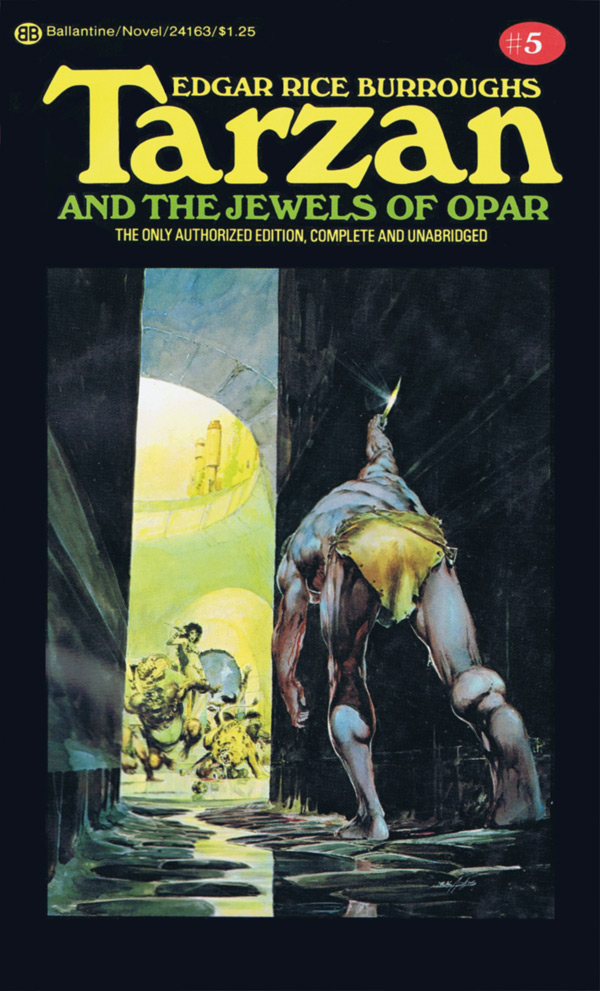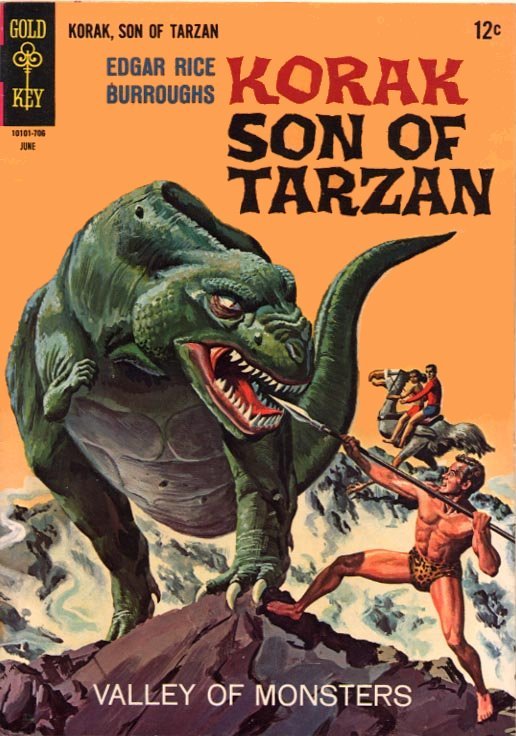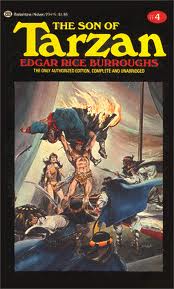The Great Tarzan Adventure #5: Tarzan and the Jewels of Opar
 Thursday, May 29, 2014 at 02:44PM
Thursday, May 29, 2014 at 02:44PM  Burroughs’s fifth Tarzan novel, Tarzan of the Jewels of Opar, is the first, to me anyhow, that read like a stand-alone adventure. There were references to earlier volumes, we meet an old friend, the Waziri, and, of course, La and the lost city of Opar. Still, there is no narrative carry over the way there was with the Russian storyline. This would be a good place for the casual reader to jump in. There’s a sense of continuity but not a necessity to know it. For the dedicated reader, however, there’s little to be learned of the character or history of Tarzan.
Burroughs’s fifth Tarzan novel, Tarzan of the Jewels of Opar, is the first, to me anyhow, that read like a stand-alone adventure. There were references to earlier volumes, we meet an old friend, the Waziri, and, of course, La and the lost city of Opar. Still, there is no narrative carry over the way there was with the Russian storyline. This would be a good place for the casual reader to jump in. There’s a sense of continuity but not a necessity to know it. For the dedicated reader, however, there’s little to be learned of the character or history of Tarzan.
Be warned – spoilers ahead!
Tarzan has gone broke from some venture at the beginning of this tale. No big deal for him, since his fortune came from the lost colony of Atlantis, Opar. He simply has to go get more. Until, that is, he takes a blow to the head and awakens with amnesia. I don’t know how clichéd the plot device was during Burroughs’s time, but it just didn’t work for me. I could be biased; these types of stories tend to frustrate me. For one, I don’t like seeing the protagonist acting the opposite of the way he typically does. And for another, it just seems like a lazy, too simple way to make conflict. It happens, however, and bad stuff happens. Jane is kidnapped by a band of Arabs with plans for ransom. There’s the story of a Belgian who has murdered his officers and fled into the jungle and who gets wrapped up with the Arabs, and therefore Tarzan.
Yeah, my thoughts exactly – where’s Opar in all of this? I mean, he goes there, gets amnesia, and leaves. La does pursue him to win back a sacred knife and because she’s totally, madly in love with him, but that’s pretty much it. Everything, of course, works out in the end, but I was expecting a bit more from this one.
So, yes, I was disappointed. I rated it three on Goodreads, so I didn’t hate it. I didn’t not like it. I was just disappointed. Here’s my major complaints:
- Lack of information about Opar. Burroughs spends about a page or so info-dumping about the history of Opar, for which I’m eternally grateful . . . I just wanted more. I was expecting Tarzan to delve into the deep, dark recesses of Opar and uncover hidden truths, etc. Didn’t happen.
- La made me cringe. She made a brief but memorable appearance in Return, so I was expecting something earth-shattering here. I mean, she’s pretty ingrained in the mythology outside the novels. I wanted to know more about her, see her as a powerful woman. Didn’t happen.
- Where’s Tarzan? Was it just me, or did it seem like Tarzan was only in about half the book? I wanted him exploring a lost world, battling strange beasts . . . Didn’t happen.
- Where’s Korak and Meriem? They were introduced as a great power couple in the last book. No, I didn’t expect them to reside at the Tarzan mansion, but I did expect them to at least be mentioned once. Didn’t happen.
- An uncomfortable number of lions died in the course of the story.
If I could point to one thing that saved the book from total disillusion, it was Mugambi and the Waziri. I was especially glad to see the return of Tarzan’s companion from Beasts, and his and the Waziri’s defense of Jane ranks as one of my favorite Edgar Rice Burroughs scenes. Probably in my top twenty of reading period. When the Arabs are attacking the Greystoke estate, the Warzir, lead by Mugambi, are gradually pushed into the house, then into the very room where Jane has sought refuge. They fight and die, not giving an inch freely. It was like a scene from Cy Endfield’s Zulu. When Mugambi fell, I was genuinely saddened. What a way to go though – very memorable. And then when Burroughs brought him back, I can honestly say I wasn’t totally surprised. I usually hate tricks like this one because they make the powerful death scene seem cheapened; it feels like a cheat. Not this time. I hope to see Mugambi later. (Of course, I wrote the same thing about Korak and Meriem last time, and look where that got me.)
The Jewels of Opar, by far, has been the biggest disappointment for me so far on this journey. I probably sound a bit more bitter than I actually am, but I was so looking forward to this one, more than many of the others just based on titles. Oh well, I’ve still got nineteen to go. I expect there will be lots of ups and downs along the way. Next on the list is The Jungle Tales of Tarzan. It’s a collection of short stories from Tarzan’s youth. If you’ve been thinking about joining the Adventure, here’s probably a very good chance to climb on board.
See you next time!








